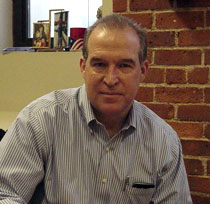Click below for the full story.
Revolution Leaps Beyond Evolution
Bright Future for "Glow-in-the-dark" Fabric
Biomedicine Generates New Life For Textile Maker
with Bill Smith
April 2007
Dealing with the International Marketplace: A Focus on CAFTA
Concordia Fibers
Biomedicine Generates New Life
For Textile Maker

Concordia Fibers has a “reputation for doing unusual things with yarns,” says its CEO Randal Spencer.
And that innovative spirit has brought this New England texiles maker into many different areas in its 86 years – from its start manufacturing silk yarns and making nylon during the World War II era, to developing composites used in stealth aircraft and high-performance tennis racquets.
But its newest and fastest growing market, biomedical textiles, is the one the company is betting will keep Concordia going long into the 21st century, despite the ever-toughening textiles battleground.
And Spencer feels much more confident about the company’s future now than in the 1990s, when he saw the rise of lower-cost Asian textile makers and demise of many traditional players.
“The writing on the wall was clear,” says the 53-year old president and CEO, who is leading the company’s transformation. “I was quite worried. We had to do something to transfer our skills to higher value-added opportunities than our traditional markets were offering us.”
At Concordia, reinvention has been critical and constant. In fact, Spencer says, even in its traditional business, the company has had to transform its product line about every year to keep it and its customers competitive.
Through its many incarnations, Concordia has stayed true to its roots and core strengths of handling and manipulating fibers and filaments to develop innovative fabric structures.
‘Amazing Stuff’
Biomedicine was an opportunity that came knocking on Concordia’s Rhode Island doors in the early 2000s, when one of the country’s largest medical device manufacturers sought its help in forming a new bioabsorbable fabric for tissue engineering.
“We had been trying to push the envelope for some time,” Spencer says. “The challenge intrigued us. We are good at rapid prototyping. We said ‘give us the filaments and see if we can engineer them into a yarn.’”
The company was only able to supply a few grams of the delicate filaments to work with. But within months, Concordia designed and built a machine that turned these individual strands into a yarn suitable for knitting.
Since then, the future has been biomedical. Concordia’s latest development, Biofelt®, is a nonwoven 3-D felt that can be absorbed by the human body and used to grow new cells and tissue.
These days, the company’s experienced textile workers, who Spencer says have “hand smarts,” are learning new skills in the medical area alongside medical engineers.
Concordia is also involved in research projects at the top universities in the country and Spencer is regularly in dialogue with doctors, cardiologists and cell biologists.
“We have been able to do some pretty amazing things that have surprised us,” he says. “People are excited and morale is good.”
With the 2005 acquisition of a biomedical business of Albany International Research Co., and the expansion of its sterile clean room, medical textiles is growing and now represents about 25 percent of the overall business.
Going forward, technical yarns and threads still will be an important part of the company’s business. And Concordia will continue to bring innovation, higher value and technical expertise to the table.
Spencer sees the two sides of the business complementing each other, each fueling new ideas for the other. Together, they keep his machinery running and 60 workers on the job.
For other textile companies that know they need to change, Spencer offers this advice learned from experience: “Don’t give up. Keep fighting. A lot can be said for perseverance. Really keep your ears open for unique opportunities. If you hear your customer has a problem, listen carefully and make it an opportunity and don’t rule it out even if it doesn’t fit at first blush.”
© 1996 Techtextil, Messe Frankfurt Exhibition GmbH